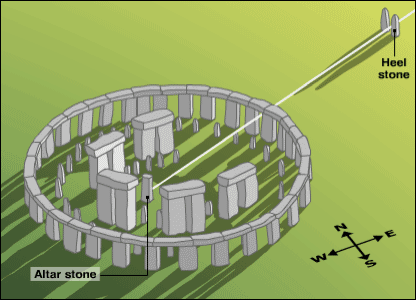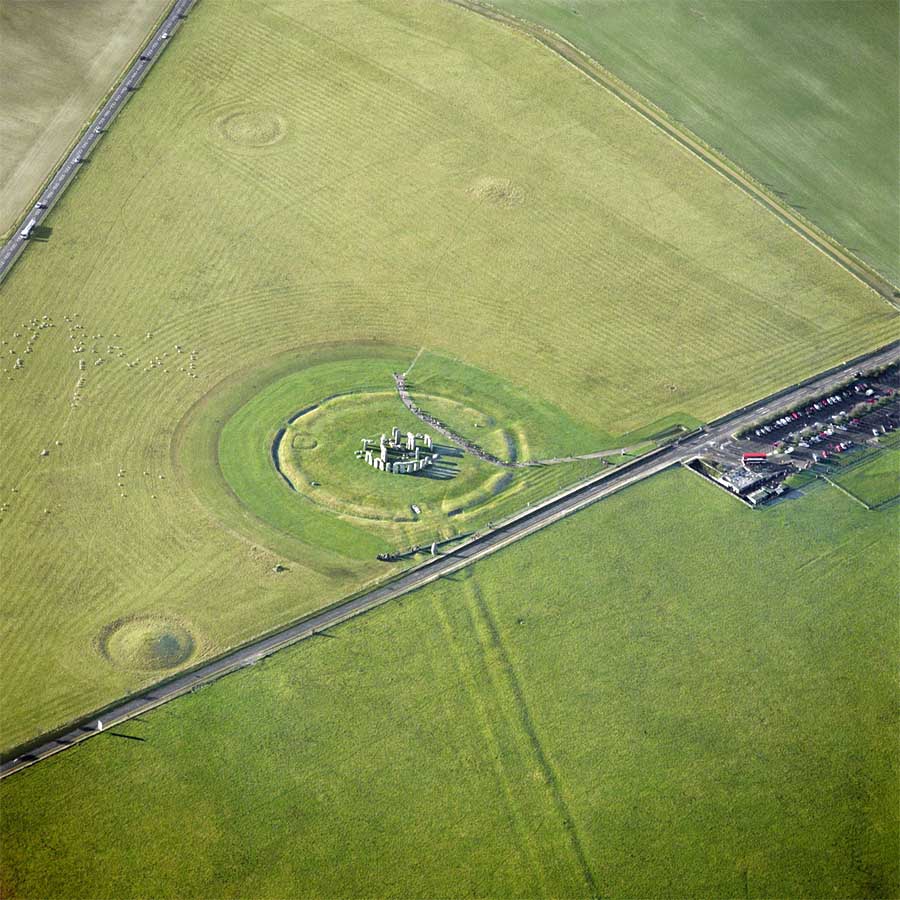 Stonehenge is surely Britain's greatest national icon, symbolizing mystery, power and endurance. Its original purpose is
unclear to us, but some have speculated that it was a temple made for
the worship of ancient earth deities. It has been called an astronomical
observatory for marking significant events on the prehistoric calendar.
Others claim that it was a sacred site for the burial of high-ranking
citizens from the societies of long ago. While we can't say
with any degree of certainty what it was for, we can say that it wasn't
constructed for any casual purpose. Only something very important to the
ancients would have been worth the effort and investment that it took
to construct Stonehenge.
Stonehenge is surely Britain's greatest national icon, symbolizing mystery, power and endurance. Its original purpose is
unclear to us, but some have speculated that it was a temple made for
the worship of ancient earth deities. It has been called an astronomical
observatory for marking significant events on the prehistoric calendar.
Others claim that it was a sacred site for the burial of high-ranking
citizens from the societies of long ago. While we can't say
with any degree of certainty what it was for, we can say that it wasn't
constructed for any casual purpose. Only something very important to the
ancients would have been worth the effort and investment that it took
to construct Stonehenge.
The stones we see today represent Stonehenge in ruin. Many of the original
stones have fallen or been removed by previous generations for home construction
or road repair. There has been serious damage to some of the smaller bluestones
resulting from close visitor contact (prohibited since 1978) and the prehistoric
carvings on the larger sarsen stones show signs of significant wear.
 The question of who built Stonehenge is largely unanswered, even today.
The monument's construction has been attributed to many ancient peoples
throughout the years, but the most captivating and enduring attribution
has been to the Druids. This erroneous connection was first made around
3 centuries ago by the antiquary, John Aubrey. Julius Caesar and other Roman
writers told of a Celtic priesthood who flourished around the time of their
first conquest (55 BC). By this time, though, the stones had been standing
for 2,000 years, and were, perhaps, already in a ruined condition. Besides,
the Druids worshiped in forest temples and had no need for stone structures.
The question of who built Stonehenge is largely unanswered, even today.
The monument's construction has been attributed to many ancient peoples
throughout the years, but the most captivating and enduring attribution
has been to the Druids. This erroneous connection was first made around
3 centuries ago by the antiquary, John Aubrey. Julius Caesar and other Roman
writers told of a Celtic priesthood who flourished around the time of their
first conquest (55 BC). By this time, though, the stones had been standing
for 2,000 years, and were, perhaps, already in a ruined condition. Besides,
the Druids worshiped in forest temples and had no need for stone structures.
The legend of King Arthur provides another story of the construction of
Stonehenge. It is told by the twelfth century writer, Geoffrey of Monmouth,
in his History of the Kings of Britain
that Merlin brought the stones to the Salisbury Plain from Ireland.
Sometime in the fifth century, there had been a massacre of 300 British
noblemen by the treacherous Saxon leader, Hengest. Geoffrey tells us
that the high king, Aurelius Ambrosius, wanted to create a fitting
memorial to the slain men. Merlin
suggested an expedition to Ireland for the purpose of transplanting the
Giant's Ring stone circle to Britain.
 According to Geoffrey of Monmouth, the stones of the Giant's Ring were originally
brought from Africa to Ireland by giants (who else but giants could handle
the job?). The stones were located on "Mount Killaraus" and were
used as a site for performing rituals and for healing. Led by King Uther
and Merlin, the expedition arrived at the spot in Ireland. The Britons,
none of whom were giants, apparently, were unsuccessful in their attempts
to move the great stones. At this point, Merlin realized that only his magic
arts would turn the trick. So, they were dismantled and shipped back to
Britain where they were set up (see illus. at right) as they had been before, in a great circle,
around the mass grave of the murdered noblemen. The story goes on to tell
that Aurelius, Uther and Arthur's successor, Constantine were also buried
there in their time.
According to Geoffrey of Monmouth, the stones of the Giant's Ring were originally
brought from Africa to Ireland by giants (who else but giants could handle
the job?). The stones were located on "Mount Killaraus" and were
used as a site for performing rituals and for healing. Led by King Uther
and Merlin, the expedition arrived at the spot in Ireland. The Britons,
none of whom were giants, apparently, were unsuccessful in their attempts
to move the great stones. At this point, Merlin realized that only his magic
arts would turn the trick. So, they were dismantled and shipped back to
Britain where they were set up (see illus. at right) as they had been before, in a great circle,
around the mass grave of the murdered noblemen. The story goes on to tell
that Aurelius, Uther and Arthur's successor, Constantine were also buried
there in their time.
 According to Geoffrey of Monmouth, the stones of the Giant's Ring were originally
brought from Africa to Ireland by giants (who else but giants could handle
the job?). The stones were located on "Mount Killaraus" and were
used as a site for performing rituals and for healing. Led by King Uther
and Merlin, the expedition arrived at the spot in Ireland. The Britons,
none of whom were giants, apparently, were unsuccessful in their attempts
to move the great stones. At this point, Merlin realized that only his magic
arts would turn the trick. So, they were dismantled and shipped back to
Britain where they were set up (see illus. at right) as they had been before, in a great circle,
around the mass grave of the murdered noblemen. The story goes on to tell
that Aurelius, Uther and Arthur's successor, Constantine were also buried
there in their time.
According to Geoffrey of Monmouth, the stones of the Giant's Ring were originally
brought from Africa to Ireland by giants (who else but giants could handle
the job?). The stones were located on "Mount Killaraus" and were
used as a site for performing rituals and for healing. Led by King Uther
and Merlin, the expedition arrived at the spot in Ireland. The Britons,
none of whom were giants, apparently, were unsuccessful in their attempts
to move the great stones. At this point, Merlin realized that only his magic
arts would turn the trick. So, they were dismantled and shipped back to
Britain where they were set up (see illus. at right) as they had been before, in a great circle,
around the mass grave of the murdered noblemen. The story goes on to tell
that Aurelius, Uther and Arthur's successor, Constantine were also buried
there in their time. In the 1960's astronomer Gerald Hawkins used a computer to
provide the first concrete evidence that Stonehenge was used
as a device for observing the heavens. He found that the placement
of key stones lined up precisely with certain events such as
the Solstices and Equinoxes. He claimed that Stonehenge could
even be used as a type of computer to predict eclipses and track
heavenly bodies across the sky. The numerous alignments are clearly
no accident, but whether this was the monuments true purpose,
however, is still far from being agreed on. The monument seems
too grand to be a simple calendar and many of the alignments
touted would not even be visible due to the stone's great height.
In the 1960's astronomer Gerald Hawkins used a computer to
provide the first concrete evidence that Stonehenge was used
as a device for observing the heavens. He found that the placement
of key stones lined up precisely with certain events such as
the Solstices and Equinoxes. He claimed that Stonehenge could
even be used as a type of computer to predict eclipses and track
heavenly bodies across the sky. The numerous alignments are clearly
no accident, but whether this was the monuments true purpose,
however, is still far from being agreed on. The monument seems
too grand to be a simple calendar and many of the alignments
touted would not even be visible due to the stone's great height.
In the 18th century the British antiquarian William Stukeley
had noticed that the horseshoe of great trilithons and the horseshoe of
19 bluestones at Stonehenge opened up in the direction of the midsummer
sunrise. It was quickly surmised that the monument must have been
deliberately oriented and planned so that on midsummer's morning the sun
rose directly over the Heel Stone and the first rays shone into the centre of the monument between the open arms of the horseshoe arrangement. This discovery has had tremendous impact on how Stonehenge has been interpreted. For Stukeley in the 18th century and Sir Norman Lockyer
in the first years of the 20th century, this alignment implied a
ritualistic connection with sun worship and it was generally concluded
that Stonehenge was constructed as a temple to the sun. More recently,
though, the astronomer Gerald Hawkins
has argued that Stonehenge is not merely aligned with solar and lunar
astronomical events, but can be used to predict other events such as
eclipses. In other words, Stonehenge was more than a temple, it was an
astronomical calculator.
It was argued that the summer solstice alignment cannot be accidental.
The sun rises in different directions in different geographical
latitudes. For the alignment to be correct, it must have been calculated
precisely for Stonehenge's latitude of 51° 11'. The alignment,
therefore, must have been fundamental to the design and placement of
Stonehenge. As if corroborating the claims made by Hawkins for
Stonehenge, Alexander Thom,
a professor of engineering and a mathematician, has shown that many
other megalithic sites throughout Britain are also oriented towards the
sun and the moon.
The alignment also made it clear that whoever built Stonehenge had
precise astronomical knowledge of the path of the sun and, moreover,
must have known before construction began precisely where the sun rose
at dawn on midsummer's morning while standing on the future site of the
monument. This point needs to be made because, as I suspect, with
Stonehenge and many other such monuments, it was the site, a particular
place within the landscape, that was important; only later were these
sites marked in some more permanent manner by the digging of ditches and
banks and (or instead) the erection of wood or stone structures. For reasons we shall never know, this particular spot in the landscape
was so important that not only were ditches and banks dug and, later,
stone circles and horseshoe arrangements constructed to mark it, but
that some of the stones were deliberately transported there with
considerable effort from a great distance away.
There are many stone circles and standing stones
in the British countryside. It is likely that they all had a
similar purpose and as with other ancient sites it is not unusual
to find alignments with major astronomical events. But Stonehenge
is unique among all the other sites in England. Its sophistication
goes beyond the simple stone circles found in other areas. It looms over the landscape, taunting
us with its mystery. One viewing this powerful structure gets
the distinct impression that they are in the presence of something
very important. Something with a purpose that perhaps has still,
after all these centuries, not been utilized. For over 5000 years
it has stood silent vigil over the earth. What will it do when
it awakens?

COOOL
ReplyDelete